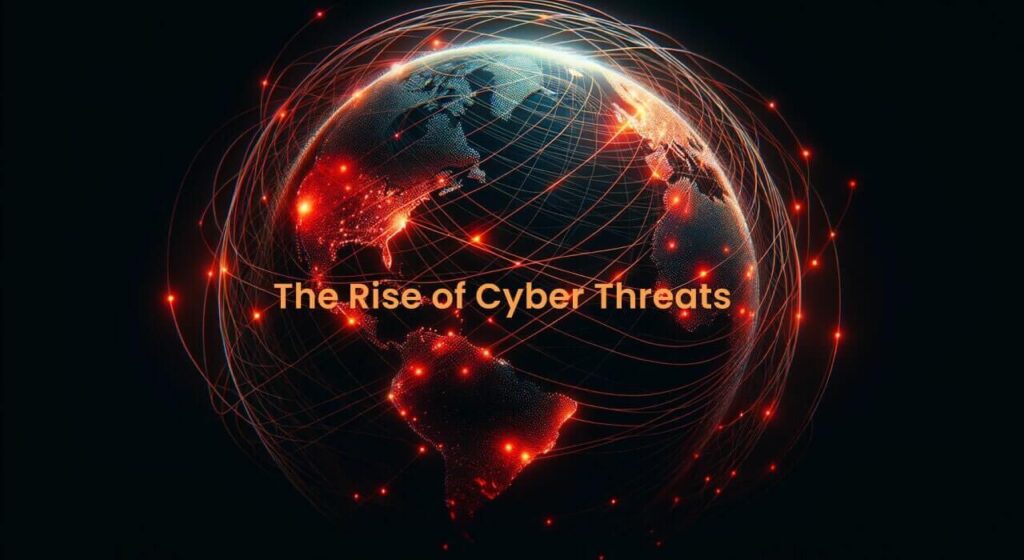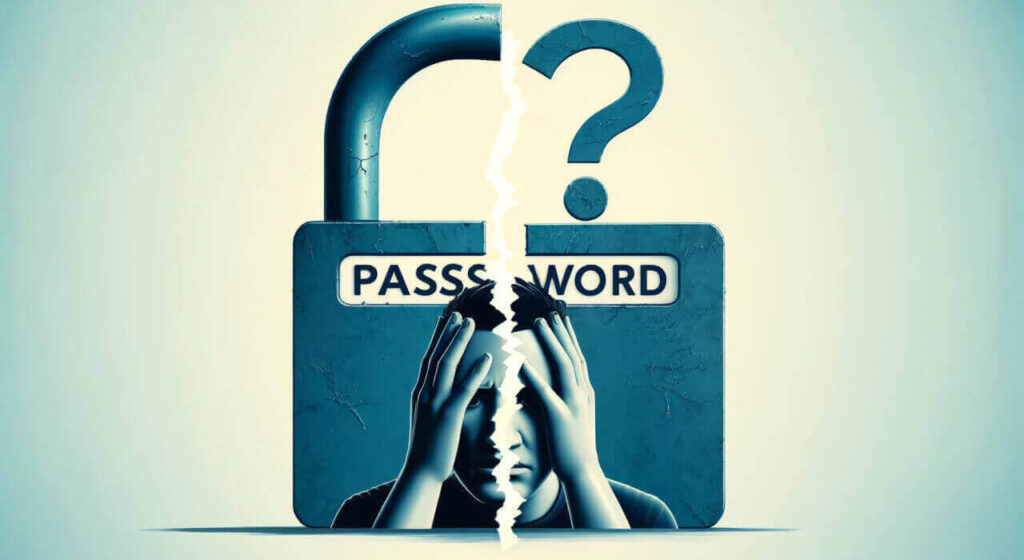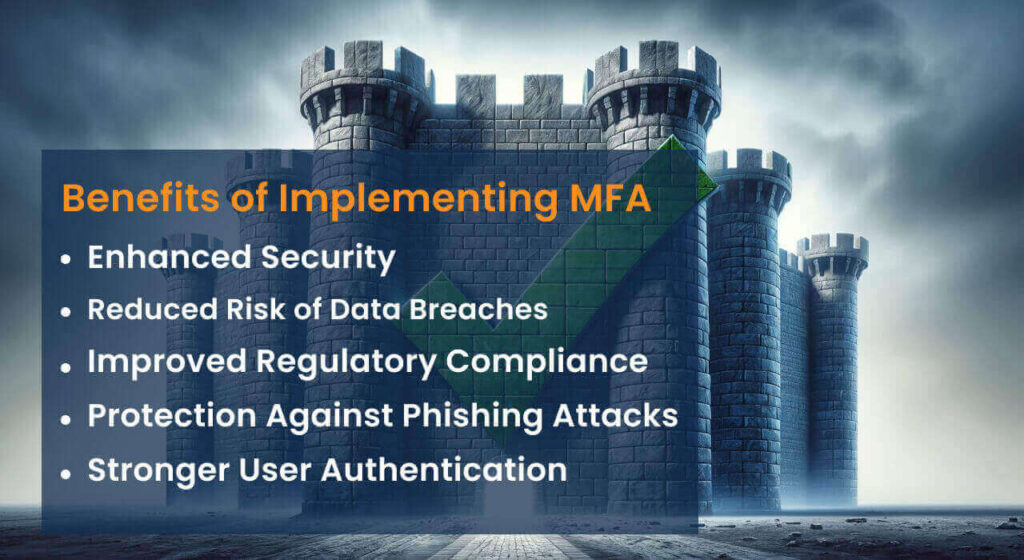
The digital landscape for businesses has become a treacherous terrain. In 2023, the IBM Security X-Force Threat Intelligence Index reported a 13% increase in the average number of attempted cyberattacks on organizations globally. These attacks are no longer the exclusive domain of large corporations. A 2022 study by Verizon found that 43% of all cyberattacks target small and medium-sized businesses (SMBs), making them prime targets due to their perceived weaker defenses.
In this ever-evolving threat environment, robust cybersecurity is no longer a luxury, but an essential business imperative. Businesses of all sizes store a wealth of sensitive data, from customer information and financial records to intellectual property. A data breach can result in severe consequences, including financial losses, harm to reputation, and potential legal ramifications.
Fortunately, a powerful tool exists to fortify your organization’s defenses: Multi-Factor Authentication (MFA). Multi-factor authentication (MFA) enhances security by introducing an additional layer of protection beyond conventional passwords. Passwords, despite their ubiquity, are inherently vulnerable. Studies reveal that a staggering percentage of users resort to weak passwords, reuse them across multiple accounts, or fall victim to social engineering tactics that trick them into revealing their credentials. Single-factor authentication (SFA), which relies solely on passwords for access, is simply not enough in today’s threat landscape. A compromised password grants an attacker unrestricted access to your systems.
MFA addresses these limitations by requiring users to provide at least two different verification factors during the login process. This significantly strengthens the authentication process and makes unauthorized access exponentially more difficult. By implementing MFA, businesses can significantly enhance security, bolster data protection, and achieve greater peace of mind.
This article delves deep into the world of MFA, exploring its various forms, its numerous benefits for businesses and how organizations can leverage this powerful security tool to safeguard their valuable assets.
The Rise of Cyber Threats

The contemporary business landscape is fraught with a constantly evolving barrage of cyberattacks. The 2023 Cisco Cybersecurity Threat Trends Report [1] paints a stark picture, highlighting a 17% year-over-year increase in the sophistication of cyberattacks. These assaults are no longer rudimentary attempts to breach basic security measures. Malicious actors are employing increasingly complex techniques, exploiting vulnerabilities in software and human behavior to gain unauthorized access to sensitive data.
Beyond the growing sophistication of attacks, the sheer frequency with which businesses are targeted is alarming. Common cyber threats include malware installations that disrupt operations and steal data, phishing campaigns that trick employees into revealing credentials, and data breaches that expose sensitive information. These threats pose a significant financial risk, with the average global cost of a data breach reaching a staggering $4.45 million in 2023 according to the IBM Security Cost of a Data Breach Report 2023 [2]. Furthermore, data breaches can erode consumer trust and damage a company’s reputation, potentially leading to lost sales and a decline in market share.
Resources:
- [1] 2023 Cisco Cybersecurity Threat Trends Report: https://www.cisco.com/c/en/us/products/security/cybersecurity-reports.html
- [2] IBM Security Cost of a Data Breach Report 2023: https://www.ibm.com/reports/data-breach
The Importance of Cybersecurity for Businesses

In the data-driven landscape of modern commerce, robust cybersecurity is no longer a peripheral concern; it’s a fundamental pillar of business continuity. Businesses of all sizes serve as custodians of a vast trove of sensitive information. This includes customer data (names, addresses, payment details), financial records (bank account information, tax documents), and intellectual property (trade secrets, product designs, marketing strategies). A data breach, the unauthorized access or disclosure of this sensitive data, can trigger a devastating domino effect.
The legal consequences of a data breach can be significant. Regulatory bodies like the European Union’s General Data Protection Regulation (GDPR) and similar standards in other regions impose hefty fines for non-compliance with data protection measures. Beyond legal ramifications, a data breach can inflict irreparable damage to a company’s reputation. Consumers increasingly prioritize data privacy, and a security lapse can shatter trust, leading to customer churn and a decline in brand loyalty. Furthermore, data breaches can expose a business to financial losses through remediation costs, legal fees, and potential civil lawsuits.
Conducting a thorough cybersecurity assessment can be a vital first step for businesses to identify security gaps and vulnerabilities within their systems. This proactive approach allows businesses to implement appropriate safeguards and mitigate the risk of a data breach.
The Limits of Passwords & Single-Factor Authentication

Despite their ubiquity, passwords remain the single most vulnerable point of entry for cyberattacks. Many users fall prey to the temptation of convenience, resorting to weak password practices. This can involve password reuse across multiple accounts, employing easily guessable combinations, or succumbing to social engineering tactics like phishing emails that trick them into revealing their credentials. A recent study by Verizon found that a staggering 80% of data breaches involved compromised passwords, highlighting the inherent flaws in this singular layer of security.
Single-Factor Authentication (SFA) solely relies on passwords for user verification. This method assumes that only the legitimate user possesses the correct password. However, in today’s threat landscape, this assumption is increasingly risky. Cybercriminals employ sophisticated techniques to crack weak passwords or steal them through phishing scams. Once a password is compromised, an attacker gains unrestricted access to a user’s account and the sensitive data it may contain. SFA’s singular reliance on passwords leaves businesses exposed and vulnerable to these ever-evolving threats.
Introducing Multi-Factor Authentication (MFA)
Multi-Factor Authentication (MFA) addresses the limitations of passwords by adding a powerful extra layer of security to the login process. In simpler terms, MFA goes beyond just “what you know” (your password) and requires verification from at least two different categories of factors.

These factors can be broadly categorized into three types:
- Something you know: This includes traditional passwords, PINs, or security questions.
- Something you have: This category encompasses physical tokens, such as hardware keys or one-time codes generated by mobile authenticator apps.
- Something you are: Biometric authentication factors like fingerprints, facial recognition, or iris scans fall into this category.
MFA significantly strengthens access control by requiring users to possess at least two of these factors for successful login. Even if a cybercriminal manages to steal a password, they would still be unable to access an account without possessing the additional factor, such as a security token or a fingerprint scan. This multi-layered approach significantly reduces the risk of unauthorized access and bolsters the overall security posture of your organization.
Benefits of Implementing MFA for Businesses

The advantages of implementing Multi-Factor Authentication (MFA) for businesses are multifaceted and far-reaching. MFA goes beyond simply adding another step to the login process; it fundamentally transforms how businesses approach user authentication, creating a more secure digital environment. Here are some key benefits that businesses can reap from adopting MFA:
Enhanced Security
MFA acts as a formidable barrier against unauthorized access attempts. By requiring possession of at least two authentication factors, it exponentially increases the difficulty for cybercriminals to breach a user account. Even if an attacker manages to steal a password through phishing or other means, they would still be unable to gain access without the additional factor, such as a security token or a fingerprint scan. This significantly reduces the risk of unauthorized access and bolsters the overall security posture of your organization.
Reduced Risk of Data Breaches
Data breaches are a costly and reputationally damaging consequence of compromised user credentials. MFA significantly reduces this risk by making it much harder for attackers to gain access to sensitive data. Since compromised passwords alone are no longer sufficient for access, cybercriminals are far less likely to succeed in their attempts to infiltrate business systems and steal valuable data. This translates to a more secure environment for your business and your customers’ information.
Improved Regulatory Compliance
Many industries and regions have established regulations that mandate specific data security measures. MFA can play a crucial role in helping businesses achieve compliance with these regulations. By implementing a robust MFA solution, businesses demonstrate a proactive approach to data security and can fulfill compliance requirements set forth by regulatory bodies like the General Data Protection Regulation (GDPR) in the European Union.
Protection Against Phishing Attacks
Phishing emails are a common tactic employed by cybercriminals to trick users into revealing their login credentials. MFA mitigates the effectiveness of these attacks. Since even a stolen password wouldn’t grant access without the additional factor, phishing attempts become significantly less successful. This safeguards your employees and reduces the risk of falling victim to social engineering tactics.
Stronger User Authentication
MFA provides a more robust and reliable method for verifying user identities. By requiring multiple factors for login, it adds an extra layer of confidence that the person attempting to access an account is indeed who they claim to be. This not only strengthens overall security but also helps to prevent unauthorized access attempts by malicious actors.
Types of Multi-Factor Authentication
MFA leverages two main categories of authentication factors to strengthen the login process. The first category comprises knowledge factors, which are pieces of information the user remembers. These include:

- Passwords: The most common knowledge factor, but also the most vulnerable due to potential weaknesses like reuse or ease of guessing.
- PINs (Personal Identification Numbers): Similar to passwords but typically shorter and used for specific purposes like ATM access.
- Security Questions: Pre-defined questions users must answer during the login process, such as “What was your childhood nickname?” However, these can be susceptible to social engineering attacks if the answers are easily discoverable.
The second category consists of possession factors, which require the user to have physical possession of a specific device or item. Examples of possession factors include:
- Hardware tokens: Dedicated physical devices that generate one-time codes for login, offering a high level of security.
- Software tokens (authenticator apps): These mobile applications generate one-time codes similar to hardware tokens, but leverage a smartphone for convenience.
- SMS verification: A common method where a one-time code is sent via text message to the user’s registered phone number for login verification. While convenient, SMS verification can be less secure than hardware or software tokens due to potential vulnerabilities in mobile phone networks.
Choosing the right combination of MFA factors depends on your organization’s specific needs and security requirements.
Choosing the Right MFA Solution
Selecting the most suitable Multi-Factor Authentication (MFA) solution for your business requires careful consideration of several key factors. Ease of use is paramount. An overly complex MFA system can lead to user frustration and potentially hinder adoption rates. The chosen solution should offer a seamless login experience that minimizes disruption to daily workflows.
Scalability is another crucial aspect. As your business grows, your MFA solution should be able to adapt and accommodate an expanding user base without compromising performance. Furthermore, ensure the solution is compatible with your existing IT infrastructure to avoid integration challenges.
Beyond these core considerations, additional factors come into play. Cost is a significant element, with various MFA solutions offering different pricing structures. Evaluate the cost-benefit ratio and choose a solution that aligns with your budget while delivering robust security. Integration with existing security systems and directory services can streamline deployment and enhance overall security posture.
Given the evolving threat landscape and the specific needs of each organization, navigating the world of MFA solutions can be complex. For a comprehensive cybersecurity assessment and guidance on selecting the most suitable MFA solution for your business, consulting with qualified cybersecurity professionals is highly recommended. These specialists can provide expert advice on implementing a robust MFA strategy that effectively safeguards your valuable data and strengthens your overall cybersecurity posture.
For a deeper understanding of how to tailor your cybersecurity approach to comply with industry-specific regulations, we recommend reading our article titled “Compliance with Industry-Specific Regulations: Tailoring Your Cybersecurity Approach.” This insightful piece explores the importance of adhering to regulatory frameworks such as the Gramm-Leach-Bliley Act (GLBA), Health Insurance Portability and Accountability Act (HIPAA), and others, and provides practical guidance on navigating the complex landscape of cybersecurity compliance.
Categorized in:
Comments